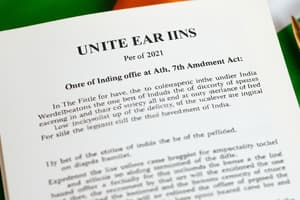Podcast
Questions and Answers
For amendments relating to Election Commission, Presidential and Vice-Presidential elections, and matters of procedure in Parliament, a ______ majority is required in both houses of Parliament
For amendments relating to Election Commission, Presidential and Vice-Presidential elections, and matters of procedure in Parliament, a ______ majority is required in both houses of Parliament
simple
For all other amendments, a ______ majority is required in India's Constitution
For all other amendments, a ______ majority is required in India's Constitution
special
A two-thirds majority in each house of Parliament is required for amendments under the ______ majority procedure
A two-thirds majority in each house of Parliament is required for amendments under the ______ majority procedure
special
To amend India's Constitution, consent from at least one-half of the ______ legislative assemblies is needed
To amend India's Constitution, consent from at least one-half of the ______ legislative assemblies is needed
The Fourth Amendment (1955) extended the scope of Article 368 to include any provision in the Constitution that has been held to be ______, inoperative, or invalid.
The Fourth Amendment (1955) extended the scope of Article 368 to include any provision in the Constitution that has been held to be ______, inoperative, or invalid.
The Twenty-fourth Amendment (1971) eliminated the requirement of a separate presidential election for each state and permitted the President to be elected indirectly by an electoral ______.
The Twenty-fourth Amendment (1971) eliminated the requirement of a separate presidential election for each state and permitted the President to be elected indirectly by an electoral ______.
The Forty-second Amendment (1976) aimed to consolidate the power of the executive and expand the scope of the Directive Principles of State ______.
The Forty-second Amendment (1976) aimed to consolidate the power of the executive and expand the scope of the Directive Principles of State ______.
The Sixty-fourth Amendment (1992) enabled the reservation of seats for women in local ______.
The Sixty-fourth Amendment (1992) enabled the reservation of seats for women in local ______.
The Ninety-ninth Amendment (2014) made the Right to Information Act more robust by inserting it as a fundamental ______ in the Constitution.
The Ninety-ninth Amendment (2014) made the Right to Information Act more robust by inserting it as a fundamental ______ in the Constitution.
The One Hundred and Twelfth Amendment (2019) reformed the constitutional basis of the judiciary by replacing the Judges' Inquiry Act with the National Judicial Appointments ______.
The One Hundred and Twelfth Amendment (2019) reformed the constitutional basis of the judiciary by replacing the Judges' Inquiry Act with the National Judicial Appointments ______.
Study Notes
Civics: Amending India's Constitution
India's Constitution is a remarkable living document that has been shaped by the nation's history, its diverse culture, and its democratic ethos. Like any other constitutional framework, it is subject to change when necessary to reflect the evolving needs of the nation. This article will focus on the process of amending India's Constitution, illuminating the methods, requirements, and some significant amendments that have shaped our nation's progress.
Amending the Constitution
Amending India's Constitution requires a careful consideration of the balance between the need for change and the stability of fundamental principles. The process has been designed to ensure that amendments are considered in light of the Constitution's spirit and not used for arbitrary purposes.
Under Article 368 of the Constitution, there are two procedures for amendment:
-
Simple majority: For amendments relating to Election Commission, Presidential and Vice-Presidential elections, and matters of procedure in Parliament, a simple majority is required in both houses of Parliament.
-
Special majority: For all other amendments, a special majority is required. This involves:
a. A two-thirds majority in each house of Parliament
b. Consent from at least one-half of the state legislative assemblies, i.e., at least 15 state legislatures.
Once these conditions are met, the President gives assent to the amendment and notifies it in the official gazette.
Notable Amendments
Several amendments to India's Constitution have enriched the nation's democratic fabric and improved aspects of its governance. Here are a few significant amendments:
-
First Amendment (1951): Introduced the official language policy, providing for Hindi as the official language of the Union and English as an associate official language.
-
Fourth Amendment (1955): Extended the scope of Article 368 to include any provision in the Constitution that has been held to be void, inoperative, or invalid.
-
Twenty-fourth Amendment (1971): Eliminated the requirement of a separate presidential election for each state and permitted the President to be elected indirectly by an electoral college.
-
Forty-second Amendment (1976): Aimed to consolidate the power of the executive and expand the scope of the Directive Principles of State Policy.
-
Sixty-fourth Amendment (1992): Enabled the reservation of seats for women in local bodies, and the Seventy-third and Seventy-fourth Amendments (1993) instituted the Panchayati Raj and Nagarpalika systems, respectively.
-
Ninety-ninth Amendment (2014): Made the Right to Information Act more robust by inserting it as a fundamental right in the Constitution.
-
One Hundred and Twelfth Amendment (2019): Reformed the constitutional basis of the judiciary by replacing the Judges' Inquiry Act with the National Judicial Appointments Commission.
Amending the Amendment Process
In 1969, the Constitution was amended to make it more difficult to amend certain fundamental rights provisions, like Articles 14, 19, and 31. This change involved a new sub-clause (4) to Article 368, which specified that any amendment to fundamental rights provisions requires the support of two-thirds of the total membership of each House of Parliament and ratification by the legislative assemblies of at least one-half of the states.
Conclusion
India's Constitution has been subject to change to meet the needs of the time. The amendment process, while careful and deliberate, has evolved to balance the need for stability and the need for progress. The Constitution of India has been amended over 100 times since its inception, and each amendment has contributed to the enrichment and strengthening of our democracy. do not provide information relevant to the topic of amending the Constitution of India.
Studying That Suits You
Use AI to generate personalized quizzes and flashcards to suit your learning preferences.
Description
Test your knowledge on the process of amending India's Constitution and notable amendments that have shaped the nation's progress. Learn about the requirements, procedures, and key amendments that have influenced India's constitutional framework.




